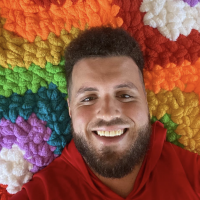As Community Engagement Professionals work to roll out and sustain Collaboratory on their campuses, it is important to recognize how students can support and further the work. Engaging students to assist with Collaboratory implementation and use not only provides benefit to the institutions, but the students as well who are encouraged to think deeply about the role of their institution in community. To illustrate the tremendous benefit students bring to engagement work and Collaboratory, students Emily Surma (IUPUI) and Evan Haut (MSU Denver) shared their insights and experiences working alongside their institutional administrators to implement and leverage Collaboratory on their campuses.
Q: How did you find out about your current position on campus to assist with Collaboratory? What attracted you to a position working in community engagement?
Emily: I found the position on our campus jobs website. It was work study funded and said that it had a focus on P-12 education and engagement. I was attracted to the job because it focused on P-12 education and the work it listed, like helping to discover how IUPUI works with Indiana schools. I thought it would be a great way to get to know IUPUI and the local schools since I am from out of state. I wanted to learn more about the community I live in and the schools where I will work in the future.
Evan: During my first semester on campus I saw the job listed as a work study position on our campus jobs website. I was drawn to the position because it said it would provide me with office experience. I liked that the position was described as flexible and fairly open, saying that I would have the opportunity to do lots of different things. I also like that I have the ability to help mold the position into doing the work that is needed as new things come up.
Q: What type of work do you do as it relates to Collaboratory?
Emily: I’ve been in this position for about two years. Before the pandemic I would meet with faculty and staff in person to learn about their engagement and proxy activities for them. Now, I meet with faculty and staff on Zoom. I do a lot of email follow up with faculty and staff that have proxied activities that they need to claim. I also did a lot of bulk importing community organizations and courses. Because I’ve worked in this position for a while I have a really good understanding of how Collaboratory works and I do a lot of administrative tasks as well, like editing content, moderating activities, running reports, etc.
Evan: I’ve worked in this position for about six months. At the beginning I did a lot of pulling and cleaning data for bulk imports. I went through the university’s organizational charts to identify internal units and their hierarchy. I also helped get data for courses and community organizations. Now, I meet with faculty a lot over Zoom to proxy activities for them and help them claim their activities. We are working to meet with faculty and enter a handful of activities in each academic department to have a broad understanding of what engagement looks like across the campus and be able to run meaningful reports in the future.
Q: What do students need to know when they start to work with Collaboratory?
Emily: Before you start entering data and talking to faculty, make sure you know how to use and maneuver within Collaboratory - what buttons to push, why you’re pushing those buttons, and know how to be able to explain it to faculty. It’s good to have a couple activity examples ready that you can share with faculty to help them think about how to enter their data. It’s important to know what data fields are captured in Collaboratory and how to talk to faculty about the best way to complete the data fields to make sure their activity is captured correctly.
Evan: Everything in Collaboratory is centered around the activity, so the data gets organized around the activity. It’s important to dig into the action about what is happening in community and then get into the other data points, like faculty and community partners, that are connected to it. This is a shift to how most faculty usually think about entering their data. It’s also good to strategize before you start reaching out to faculty. Think about questions like, "Who do we want to talk to next?" "What departments or faculty do we want to target because we know they do engagement?" "Who can we get referrals from?" "Who is open to providing data?" Lastly, it’s super important to have a really strong "why" for why you’re doing this work. The first time I met with a professor they asked, "Why are you doing this? Why should I enter data?" I was like a deer in headlights! I didn’t know. I was a new student! Talk with your administrators to understand the "why" and put that in your first outreach emails. If you can explain the “why” to faculty, they will be much more willing to help you.
Q: What tools or processes do you have set up to help manage and organize your Collaboratory work?
Emily: Excel files! When I work with faculty I keep detailed notes that align with the data that’s captured in Collaboratory, so I can proxy their information later. I use the Collaboratory activity report as a guide when interviewing. I also have a lot of good email templates that I reuse when communicating with faculty. It’s good to include screenshots to help walk them through claiming an activity, editing activities, etc.
Evan: When I initially reach out to faculty the first thing I always have them do is login to Collaboratory so they are registered. Then, when I meet with them, I usually enter their activities for them in a screen-share and I try to submit their activities when we are still meeting, because then there is no waiting for them to come back into Collaboratory and I can help them right then, as we screen share. For faculty with lots of activities, I always ask them how they want to do it - if they’d prefer I train them so they can enter activities themselves, if I should proxy them, or if we walk through it together. Usually faculty want to do it together and screen share. When they get through two activities I’ve usually answered all their questions and they are ready to do it themselves. But make sure you are flexible and can adapt. Every faculty and department is different. Do what works best for them. A one-size-fits-all approach doesn’t work!
Q: What do you think new Collaboratory campuses need to know as they begin this work?
Emily: Focus working on faculty who are willing. Not all faculty and staff will be responsive. Be persistent, but don’t be overbearing.
Evan: Try to hire students that are really versatile because the work with Collaboratory changes and is different a lot of the time. Students will need to be comfortable with data entry but also be able to easily talk to faculty and think on their feet when faculty have questions.
Meet the Students:

Emily Surma is a junior at IUPUI, majoring in Elementary Education and getting her license in Special Education. She chose to attend IUPUI because she initially wanted to study nursing and IUPUI has a great nursing program. Emily is from out of state and came to IUPUI through the Midwestern Exchange Program, which helps to lower tuition costs.

Evan Haut is a transfer student at Metropolitan State University Denver studying Electrical Engineering Technology. Evan has an Associate of Applied Business in Business Management and Culinary Arts. Evan chose to go back to school during the pandemic because food service was completely shut down. Evan chose electrical engineering because he wants to help the power grid adapt to green energy. Evan really enjoys his position at MSU Denver’s Applied Learning Center because it offers a unique way to connect with the campus during his first year when everyone was online, and he likes the people with whom he works. Believing in the project and its future utility and benefits to both the university and community organizations helps Evan stay motivated.
Connect Students to the Collaboratory Scholars:
The Collaboratory Scholars network engages students in monthly conversations that explore new ways of thinking about Collaboratory and higher education community engagement. If your institution is currently using Collaboratory and has students who would like to join, learn more and sign up HERE.
Want to Learn More?
If your institution is not yet using Collaboratory, email info@cecollaboratory.com to learn more about how to leverage Collaboratory to tell your institution’s story of engagement.
